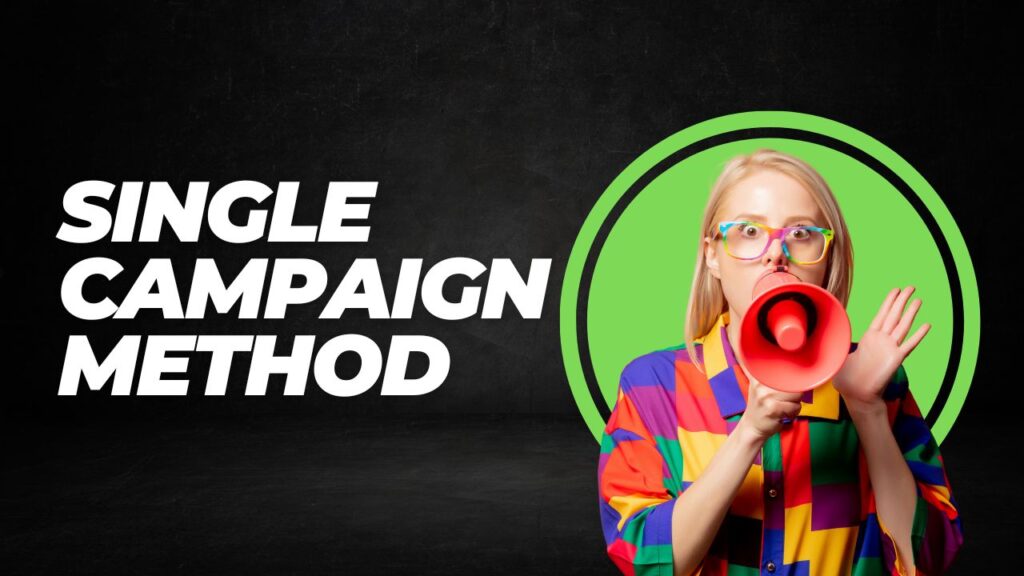What is the Single Campaign Method?
The Single Campaign Method is a strategy where you focus all your efforts on running one well-optimized campaign instead of spreading your resources across multiple campaigns. This approach allows you to concentrate on a specific goal, audience, or product, ensuring that every detail is carefully planned and executed.
Why Use the Single Campaign Method?
Here are some key benefits of using this method:
- Simplifies Management:
Managing one campaign is much easier than juggling multiple campaigns. You can focus on optimizing every aspect without feeling overwhelmed. - Improves Focus:
By concentrating on a single goal, you can create more targeted and effective ads. - Saves Time and Money:
Instead of splitting your budget across multiple campaigns, you can allocate all your resources to one high-performing campaign. - Easier to Measure Success:
With only one campaign to track, it’s simpler to analyze performance and make data-driven decisions. - Higher ROI:
A well-optimized single campaign often delivers better results than multiple underperforming campaigns.
When to Use the Single Campaign Method
This method works best in the following scenarios:
- You have a limited budget.
- You’re promoting a specific product, service, or event.
- You want to test a new strategy or audience.
- You’re a small business or startup with limited resources.
How to Implement the Single Campaign Method
Here’s a step-by-step guide to creating and running a successful single campaign:
1. Define Your Goal
Start by setting a clear and specific goal. For example:
- Increase website traffic by 20%.
- Generate 50 leads in one month.
- Sell 100 units of a new product.
2. Identify Your Target Audience
Understand who your ideal customer is. Use tools like Facebook Audience Insights or Google Analytics to gather data on demographics, interests, and behaviors.
3. Choose the Right Platform
Select the platform where your target audience is most active. For example:
- Facebook and Instagram for B2C audiences.
- LinkedIn for B2B audiences.
- Google Ads for search-based campaigns.
4. Create Compelling Content
Design ads that resonate with your audience. Use eye-catching visuals, clear messaging, and a strong call-to-action (CTA).
5. Set a Budget
Allocate your entire budget to this single campaign. Monitor spending closely to ensure you’re getting the best return on investment (ROI).
6. Launch and Monitor
Once your campaign is live, track its performance regularly. Use metrics like CTR (click-through rate), conversion rate, and ROI to measure success.
7. Optimize Continuously
Based on your data, make adjustments to improve performance. For example:
- Test different ad creatives.
- Refine your targeting.
- Adjust your budget allocation.
Tips for Success with the Single Campaign Method
- Start Small: If you’re new to this method, start with a smaller budget to test its effectiveness.
- Focus on Quality: Invest time in creating high-quality ads and landing pages.
- Use A/B Testing: Test different versions of your ads to see what works best.
- Leverage Analytics: Use tools like Google Analytics or Facebook Ads Manager to track performance.
- Be Patient: Give your campaign enough time to gather data and show results.
Common Mistakes to Avoid
- Not Defining a Clear Goal: Without a specific goal, it’s hard to measure success.
- Ignoring Data: Failing to analyze performance can lead to missed opportunities for optimization.
- Overcomplicating the Campaign: Keep your campaign simple and focused.
- Not Testing Enough: Always test different elements to find the best-performing combination.
Final Thoughts
The Single Campaign Method is a powerful strategy for businesses and marketers looking to maximize their results with focused efforts. Whether you’re a small business owner or someone taking digital marketing training in Kerala, this method can help you achieve your goals more efficiently.



